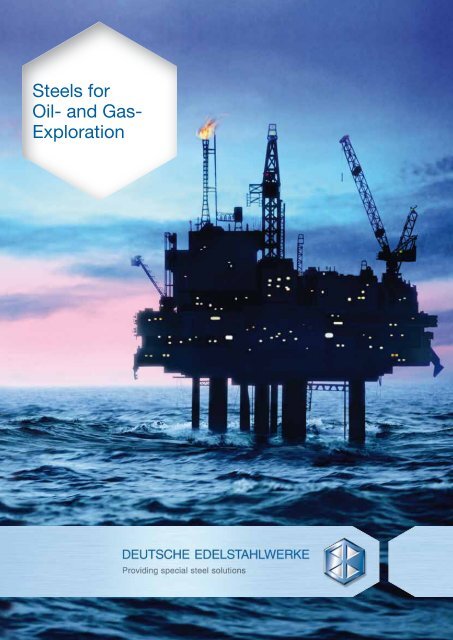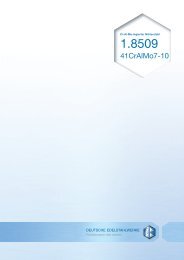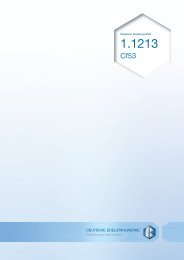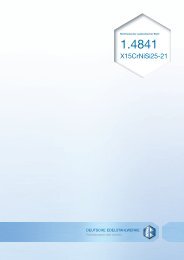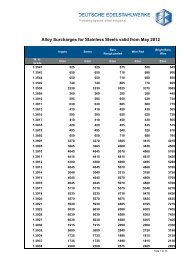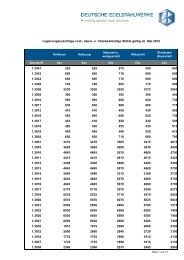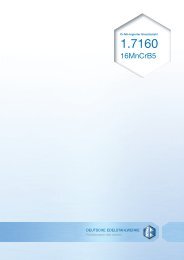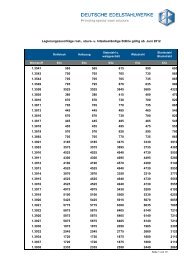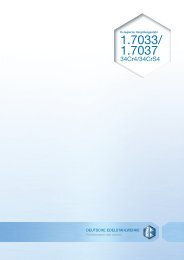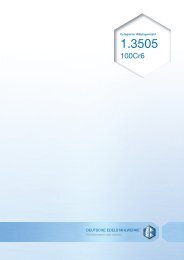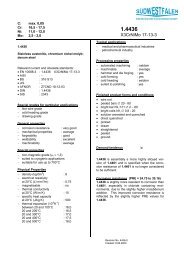Steels for Oil- and Gas- Exploration - DEW-STAHL.COM
Steels for Oil- and Gas- Exploration - DEW-STAHL.COM
Steels for Oil- and Gas- Exploration - DEW-STAHL.COM
Create successful ePaper yourself
Turn your PDF publications into a flip-book with our unique Google optimized e-Paper software.
<strong>Steels</strong> <strong>for</strong><br />
<strong>Oil</strong>- <strong>and</strong> <strong>Gas</strong>-<br />
<strong>Exploration</strong>
Providing<br />
special steel<br />
solutions<br />
In search of new oil <strong>and</strong> gas sources high per<strong>for</strong>mance<br />
steels with defined mechanical, physical <strong>and</strong> chemical<br />
properties are required.<br />
New oil <strong>and</strong> gas fields have been identified in large<br />
depths under the sea. The tools <strong>for</strong> exploring these<br />
fields are exposed to various rock <strong>for</strong>mations <strong>and</strong><br />
aggressive media which react with the tools being used.<br />
Depending on the ambient conditions special high strength steels with<br />
a high resistance to corrosion are required.<br />
Deutsche Edelstahlwerke possess more than 150 years of experience<br />
in the development <strong>and</strong> production of special steels <strong>and</strong> are thus ideally<br />
suited to be your partner in the supply of special steels.<br />
This brochure provides in<strong>for</strong>mation about the production routes <strong>for</strong><br />
special oil tool steels <strong>and</strong> the products which we are able to deliver.<br />
Furthermore, mechanical <strong>and</strong> physical properties as well as the corrosion<br />
resistance properties of stainless grades are provided.<br />
02
Our technology <strong>and</strong> experience – your guarantee <strong>for</strong> premium quality<br />
The purity <strong>and</strong> homogeneity of our special<br />
steels stem from producing them in our<br />
modern steelworks. We fulfill our clients‚<br />
predefined dem<strong>and</strong>s by means of precision<br />
alloying <strong>and</strong> optimized process specifications<br />
<strong>for</strong> melting, shaping <strong>and</strong> heat treating.<br />
Our state of the art melting <strong>and</strong> combination<br />
of ingot <strong>and</strong> vertical continuous casting allow<br />
bars of various dimensions to be hot rolled or<br />
<strong>for</strong>ged. Usually an optimized vertical continuous<br />
casting method is used, but <strong>for</strong> large <strong>for</strong>ging<br />
sizes, ingot casting is employed.<br />
Our combination of processing facilities are<br />
unique world wide <strong>and</strong> allow us to produce all<br />
<strong>for</strong>ms of long products required by the market.<br />
With our electroslag <strong>and</strong> vacuum remelting<br />
facilities we are also an important player in<br />
other special steel markets, <strong>for</strong> example the<br />
aerospace industry.<br />
Hot <strong>for</strong>ming<br />
Our rolling mills are capable of producing hot<br />
rolled bars up to 250 mm (10 inches), as well<br />
as flat plates.<br />
Our <strong>for</strong>ges are equipped with a 33 MN <strong>and</strong><br />
45 MN press, a GFM RF 70 (currently the<br />
largest in the world) <strong>and</strong> a GFM LSX 25 long<br />
<strong>for</strong>ging machine which allows us to produce<br />
bars <strong>and</strong> contoured <strong>for</strong>gings having a maximum<br />
diameter of 460 mm (18 inches).<br />
Heat treatment<br />
Modern heat treatment facilities are available<br />
to carry out annealing, hardening, quenching<br />
<strong>and</strong> tempering of the special steel grades.<br />
Our furnaces have been approved to the requirements<br />
of API 6 A to ensure homogenous<br />
material properties <strong>for</strong> all sections.<br />
03
Finishing<br />
Peeling <strong>and</strong> grinding machines as well as<br />
modern non-destructive testing lines, to ensure<br />
ultimate quality, are available <strong>for</strong> rolled <strong>and</strong><br />
<strong>for</strong>ged products <strong>and</strong> steel bars. Our Machining<br />
division, which is equipped with deep hole<br />
drilling, milling, turning <strong>and</strong> grinding facilities,<br />
is also capable of producing finished or semifinished<br />
components (drive subs <strong>and</strong> drill collars).<br />
For deep drilling of drill collars <strong>and</strong> bars up<br />
to 12 m (35 feet) length, 4 special drilling<br />
machines are available. This equipment has<br />
been specially developed in cooperation<br />
with the machine manufacturer.<br />
In order to guarantee an improved fatigue life<br />
<strong>and</strong> better resistance to stress corrosion<br />
cracking (SCC) in operation, a new work<br />
hardening process has been developed in<br />
which two ceramic balls rotate in contact with<br />
the inner surface of the collar (roller burnishing)<br />
to produce defined residual compressive<br />
stresses.<br />
04
Steel grades <strong>and</strong> applications<br />
Based on its extensive production facilities Deutsche Edelstahl-<br />
werke is able to supply the entire portfolio of steel grades<br />
required <strong>for</strong> oil- <strong>and</strong> gas-exploration.<br />
This includes the low <strong>and</strong> high alloyed engineering steels,<br />
ferritic <strong>and</strong> martensitic as well as high alloyed austenitic <strong>and</strong><br />
duplex stainless steels.<br />
Specialties as hot cold de<strong>for</strong>med nonmagnetic steels play<br />
a major role in the detection of new oil <strong>and</strong> gas sources.<br />
Low alloyed steels of the types SAE/AISI 41xx <strong>and</strong> 86xx series<br />
are based on the alloying elements Cr-Mo <strong>and</strong> Cr-Ni-Mo with<br />
carbon contents between 0,25 <strong>and</strong> 0,50 %. After quenching<br />
<strong>and</strong> tempering hardness according to NACE specifications<br />
<strong>and</strong> impact toughness values (Charpy-V) at low temperatures<br />
are required.<br />
Specific metallurgical procedures <strong>and</strong> heat treatments are<br />
necessary to obtain these properties in combination with<br />
a homogeneous fine grain microstructure. Typical applications<br />
<strong>for</strong> these grades include flanges, valves, blow out<br />
preventer feeders <strong>and</strong> manifolds. High strength engineering<br />
steels like SAE 4340 or 4330 V with yield strength levels<br />
> 1100 MPa (160 ksi) are more highly alloyed with Nickel-,<br />
Molybdenum- <strong>and</strong> Vanadiumcontents. These grades must<br />
exhibit enhanced toughness properties even at low temperatures<br />
<strong>and</strong> sometimes also in the transverse direction.<br />
05<br />
Shaft Typical<br />
Drill collars<br />
SAE 4145<br />
Drill collars<br />
Magnadur<br />
501<br />
MWD/LWD<br />
Magnadur<br />
601<br />
Drill bit<br />
applications of<br />
oil tool steels<br />
Stabilizer<br />
Magnadur 501<br />
Drive sub<br />
SAE 4330 V MOD
Martensitic<br />
stainless grades<br />
The directional<br />
drilling process is<br />
powered via the<br />
use of rotors which<br />
exert a rotational<br />
<strong>for</strong>ce on the drill tip<br />
by pumping drilling<br />
mud down the drill<br />
shaft. This action<br />
results in both wear<br />
<strong>and</strong> corrosion of the<br />
drive shaft <strong>and</strong> thus,<br />
suitable materials<br />
need to be used,<br />
typically the grade<br />
17-4PH (1.4542).<br />
Martensitic stainless grades<br />
Martensitic stainless grades with 13 % Cr<br />
(AISI 410 <strong>and</strong> 420) are used if the corrosion<br />
resistance of the low alloyed engineering steels<br />
is not sufficient <strong>and</strong> the required strength level<br />
is similar. Details of the Specification NACE<br />
MR 0175 with a narrow tolerance of hardness<br />
<strong>and</strong> strength have to be respected. A reliable<br />
process control in all steps of production is<br />
necessary to secure these properties.<br />
For applications like drive components (drive<br />
trains) <strong>for</strong> the drill bit within the drill string<br />
(down hole motors) precipitation hardening<br />
martensitic stainless steels with low carbon<br />
contents are used. The most common grade is<br />
the steel 17-4 PH (AISI 630) with 15-17 % Cr,<br />
5 % Ni <strong>and</strong> 3 % Cu. Since components of<br />
this grade also have to comply with the NACE<br />
specification, only the condition DH 1150 is<br />
allowed (approved). In addition to an excellent<br />
combination of strength <strong>and</strong> toughness, the<br />
pitting resistance of these steels is also good.<br />
06<br />
Austenitic stainless grades<br />
Environmental media are often contaminated<br />
with aggressive chloride ions <strong>and</strong> since austenitic<br />
steels are susceptible to stress corrosion<br />
cracking (SCC) these grades are rarely used.<br />
Duplex- <strong>and</strong> super duplex steels<br />
Duplex <strong>and</strong> super duplex stainless steels, like<br />
F 51 <strong>and</strong> F 55 (1.4462/1.4501), are specified <strong>for</strong><br />
applications where best corrosion resistance is<br />
required. These grades combine the advantages<br />
of ferritic <strong>and</strong> austenitic steels thus providing<br />
high strength, improved fatigue <strong>and</strong> corrosion<br />
resistance <strong>and</strong> better resistance to SCC.<br />
Austenitic<br />
stainless grades<br />
Duplex- <strong>and</strong><br />
super duplex steels
Requirements <strong>for</strong><br />
non mag steels:<br />
High strength<br />
> 900 MPa (130 ksi)<br />
High corrosion resistance<br />
to aggressive media<br />
(high Chloride<br />
concentration)<br />
Low magnetic permeability<br />
without any “hot spots”.<br />
HB<br />
370<br />
360<br />
350<br />
340<br />
330<br />
320<br />
310<br />
300<br />
290<br />
Nonmagnetic Drill-/spiral collar<br />
Magnadur 601<br />
Typical hardness distribution over the cross-section of a non mag bar<br />
after work hardening.<br />
280<br />
0 50 100<br />
Cross section X in mm<br />
150 200<br />
In oil <strong>and</strong> gas field applications, particular emphasis<br />
is placed on nonmagnetic steels (non mags).<br />
These steels rely upon the combination of high<br />
chromium, manganese <strong>and</strong> nitrogen contents<br />
in addition to small amounts of nickel to ensure<br />
a stable austenitic microstructure. These non<br />
mags can be work hardened to increase yield<br />
<strong>and</strong> tensile strength corresponding to the<br />
requirements of the API 7.<br />
A homogeneous austenitic microstructure is<br />
the precondition to guarantee the specified<br />
magnetic permeability of µr < 1,01.<br />
Since no magnetic inclusion or local ferritic<br />
microstructure is allowed within the material,<br />
a particular clean steel production <strong>and</strong> stringent<br />
temperature control in the subsequent hot<br />
<strong>for</strong>ming process is necessary. Non mag steels<br />
are used to house the extremely sensitive<br />
measuring instruments contained near the drill<br />
bit. MWDs (Messuring While Drilling) use the<br />
magnetic field of the earth to determine the<br />
precise position of the drilling tools <strong>and</strong> then<br />
control the direction of drilling, while LWDs<br />
(Logging While Drilling) gather in<strong>for</strong>mation<br />
about the geological <strong>for</strong>mation being drilled.<br />
Typical tools are MWDs (Measuring while<br />
drilling) <strong>and</strong> LWDs (Logging while drilling).<br />
Depending on their application, low <strong>and</strong> high<br />
strength steels are specified. For simple drill collars,<br />
heavy weights, flex collars <strong>and</strong> stabilizers with<br />
a low strength level according to API 7 the non<br />
mag grade Magnadur 501 can be used.<br />
For more dem<strong>and</strong>ing applications like MWDs<br />
with increased strength <strong>and</strong> corrosion resistance<br />
we recommend the use of the superior grade<br />
Magnadur 601. Beside the higher strength<br />
(> 150 ksi) which is obtained by a higher nitrogen<br />
content <strong>and</strong> work hardening, the resistance to<br />
corrosion is also superior.<br />
Since the corrosion resistance of these non mag<br />
grades decreases slightly with increasing strength<br />
(work hardening), it is possible to improve the<br />
corrosion properties even further by specifying a<br />
lower strength Magnadur 601 variant. This lower<br />
strength grade is also available upon request.<br />
07
Corrosion properties<br />
In oil <strong>and</strong> gas field applications, the materials<br />
used are always subjected to corrosive conditions<br />
of varying severity. In fact the dwindling<br />
reserves are <strong>for</strong>cing exploration in ever increasingly<br />
harsh environments which are sour <strong>and</strong>/<br />
or contain high levels of chlorides. In addition to<br />
this, the combination of materials used <strong>and</strong> the<br />
high strengths which are required lead to a host<br />
of different <strong>for</strong>ms of corrosion which have to<br />
be avoided. Some of the most common <strong>for</strong>ms<br />
of corrosion which are encountered include:<br />
Pitting corrosion resistance<br />
This <strong>for</strong>m of corrosion occurs when the protective<br />
passive film on stainless steels is locally<br />
damaged, allowing the corrosive environment<br />
to come into contact with the unprotected<br />
surface of the metal. The passive film is capable<br />
of regenerating itself, provided that oxygen is<br />
present in the environment, but in the presence<br />
a high concentrations of chloride ions, it is possible<br />
that the rate of destruction of the passive<br />
film is faster than the regeneration <strong>and</strong> this then<br />
results in localised corrosion or pitting. Once<br />
pits have <strong>for</strong>med, they continue to grow at<br />
an ever increasing rate until in extreme cases<br />
the metal is per<strong>for</strong>ated.<br />
The resistance of an alloy to this, un<strong>for</strong>tunately<br />
common, <strong>for</strong>m of corrosion can be estimated<br />
empirically by using the so-called pitting<br />
resistance equivalent number or PREN,<br />
which is based on the chemical composition<br />
of the steel. Generally speaking, the higher this<br />
number, the better the resistance to pitting.<br />
PREN = %Cr + 3,3 x %Mo + 16 x %N.<br />
Further differentiation is given by the pitting<br />
potential or the Critical Pitting Temperature<br />
(CPT) which is determined by following the<br />
ASTM G61 <strong>and</strong> G150.<br />
Galvanic corrosion<br />
It is almost impossible to avoid this type of<br />
corrosion which arises due to potential differences<br />
which arise when two dissimilar metals<br />
08<br />
are placed in contact with one another in an<br />
electrolyte (corrosive environment). This essentially<br />
results in the <strong>for</strong>mation of a battery in which<br />
one of the metals, the less noble, corrodes<br />
preferentially to protect the more noble metal.<br />
This <strong>for</strong>m of corrosion can be reduced by<br />
ensuring that the potential difference between<br />
two contacted metals is as small as possible<br />
<strong>and</strong> by insulating the metals so that they are<br />
not in electrical contact with one another. Tests<br />
to determine the susceptibility of metals to this<br />
<strong>for</strong>m of corrosion include visual examination<br />
after immersion in an electrolyte (140,000 ppm<br />
chloride, 71° C, 14 days).<br />
Stress corrosion cracking (SCC)<br />
This <strong>for</strong>m of corrosion arises when a susceptible<br />
material is placed in a chloride or other halide<br />
containing environment <strong>and</strong> then subjected to<br />
tensile stresses. These stresses can either be<br />
residual or applied. The removal of any one of<br />
these conditions result in the avoidance of SCC.<br />
From this we can see that the residual <strong>and</strong> applied<br />
stresses must be kept as low as possible<br />
or that steps are taken to ensure that only compressive<br />
stresses are present. The latter requirement<br />
is the reason <strong>for</strong> the purpuseful de<strong>for</strong>mation<br />
of the inner surface of the hollow bars to produce<br />
high compressive residual stresses.<br />
High nickel contents are also known to promote<br />
stress corrosion cracking <strong>and</strong> it is <strong>for</strong> this reason<br />
that high grade non mags are not alloyed with<br />
significant amounts of nickel. Susceptability<br />
to SCC can be measured according to ASTM<br />
G36, G123.<br />
Intergranular corrosion<br />
Although this <strong>for</strong>m of corrosion is readily<br />
avoidable by accurate control of the chemical<br />
analysis <strong>and</strong> by per<strong>for</strong>ming adequate heat<br />
treatment, many customers require proof that<br />
the steels supplied are free from intergranular<br />
corrosion (IGC). The most common tests to<br />
determine freedom from IGC are per<strong>for</strong>med<br />
according to ASTM A 262, Practice A <strong>and</strong> E.
Engineering steels<br />
AISI 4130/1.7216 (API 6A/NACE MR 01.75), Firmodur 7216<br />
C Si Mn P S Cr Mo Ni<br />
Min 0,28 0,15 0,40 - - 0,90 0,15 -<br />
Max 0,33 0,30 0,60 0,025 0,025 1,10 0,25 0,25<br />
0,2 %-Offset-yield strength R p0,2 in MPa (ksi) ≥ 517 (75)<br />
Tensile strength R m in MPa (ksi) ≥ 655 (95)<br />
Elongation L 0 = 4 d (A 4 ) in % ≥ 18<br />
Reduction of area (Z) in % ≥ 35<br />
Impact toughness (Charpy-V at 23° C) in J (ft-lbs) ≥ 50 J (37)<br />
Impact toughness (Charpy-V at -60° C) in J (ft-lbs) ≥ 27 (20)<br />
Hardness in BHN (HRC) 197 – 234 (18 – 22)<br />
Ultrasonic soundness ASTM A 388, API 6A PSL 3 or 4<br />
Specimens taken 25,4 mm (1 inch) below surface in longitudinal direction.<br />
AISI 4140 H – L 80/1.7223 (API 6A/5 CT/NACE MR 01.75), Firmodur 7273<br />
C Si Mn P S Cr Mo Ni<br />
Min 0,38 0,15 0,75 - - 0,90 0,15 -<br />
Max 0,43 0,30 1,00 0,025 0,025 1,20 0,25 0,25<br />
0,2 %-Offset-yield strength R p0,2 in MPa (ksi) ≥ 517 (75)<br />
Tensile strength R m in MPa (ksi) ≥ 655 (95)<br />
Elongation L 0 = 4 d (A 4 ) in % ≥ 18<br />
Reduction of area (Z) in % ≥ 35<br />
Impact toughness (Charpy-V at -32° C) in J (ft-lbs) ≥ 50 J (37)<br />
Impact toughness (Charpy-V at -60° C) in J (ft-lbs),<br />
obligatory only <strong>for</strong> bar diameter ≤ 152,4 mm/6“ ≥ 27 (20)<br />
Hardness in BHN (HRC) 197 – 234 (18 – 22)<br />
Ultrasonic soundness ASTM A 388, API 6A PSL 3 or 4<br />
Specimens taken 25,4 mm (1 inch) below surface in longitudinal direction.<br />
AISI 4145/AISI 4145 H mod/1.7225 (API 7), Firmodur 7275<br />
C Si Mn P S Cr Mo Ni<br />
Min 0,42 - 0,70 - - 0,90 0,20 -<br />
Max 0,49 0,40 1,30 0,025 0,025 1,30 0,50 0,60<br />
Diameter OD range<br />
79,4 – 174,6 mm/ > 174,6 mm/<br />
3<br />
0,2 %-Offset-yield strength R in MPa (ksi)<br />
p0,2<br />
Tensile strength R in MPa (ksi)<br />
m<br />
Elongation L = 4 d (A ) in % 0 4 ≥ 15<br />
Reduction of area (Z) in % ≥ 45<br />
Impact toughness (Charpy-V at 23° C) in J ≥ 54<br />
Impact toughness (Charpy-V at -20° C) in J ≥ 30<br />
Hardness in BHN 285 – 340<br />
Ultrasonic soundness ASTM A 388, API 6A PSL 3 or 4<br />
1 /8 – 6 7 /8 inches 6 7 /8 inches<br />
≥ 757 (110) ≥ 689 (100)<br />
≥ 965 (140) ≥ 931 (135)<br />
Specimens taken in accordance with API 7 25,4 mm (1 inch) below surface in longitudinal direction.<br />
09
Engineering steels<br />
AISI 4330V mod/1.6562, Firmodur 6562<br />
C Si Mn P S Cr Mo Ni V<br />
Min 0,29 - 0,70 - - 0,80 0,30 1,60 0,05<br />
Max 0,35 0,40 1,00 0,015 0,010 1,10 0,50 3,00 0,10<br />
Diameter OD range 80 – 250 mm/3 1 /8 – 9 3 /4 inches<br />
0,2 %-Offset-yield strength R p0,2 in MPa (ksi) 1035 – 1210 (150 – 175)<br />
Tensile strength R m in MPa (ksi) 1105 – 1310 (160 – 190)<br />
Elongation L 0 = 4 d (A 4 ) in % ≥ 15<br />
Reduction of area (Z) in % ≥ 45<br />
Impact toughness (Charpy-V at 23° C) in J ≥ 60<br />
Impact toughness (Charpy-V at -40° C) in J ≥ 27<br />
Hardness in BHN 340 – 400<br />
Ultrasonic soundness ASTM A 388, API 6A PSL 3 or 4<br />
Specimens taken 25,4 mm (1 inch) below surface in longitudinal direction.<br />
AISI 4340/1.6595, Firmodur 6595<br />
C Si Mn P S Cr Mo Ni<br />
Min 0,38 - 0,60 - - 0,70 0,20 1,60<br />
Max 0,43 0,40 0,90 0,020 0,015 1,00 0,30 2,00<br />
Diameter OD range 80 – 250 mm/3 1 /8 – 9 3 /4 inches<br />
0,2 %-Offset-yield strength R p0,2 in MPa (ksi) 1000 – 1150 (145 – 167)<br />
Tensile strength R m in MPa (ksi) 1100 – 1280 (160 – 185)<br />
Elongation L 0 = 4 d (A 4 ) in % ≥ 15<br />
Reduction of area (Z) in % ≥ 45<br />
Impact toughness (Charpy-V at 23° C) in J ≥ 60<br />
Impact toughness (Charpy-V at -40° C) in J ≥ 27<br />
Hardness in BHN 320 – 380<br />
Ultrasonic soundness ASTM A 388, API 6A PSL 3 or 4<br />
Specimens taken 25,4 mm (1 inch) below surface in longitudinal direction.<br />
AISI 8630/8630 mod/1.6591 (API 6A/NACE MR 01.75), Firmodur 6591<br />
C Si Mn P S Cr Mo Ni V Cu<br />
Min 0,28 0,15 0,75 - - 0,85 0,35 - - -<br />
Max 0,33 0,45 1,00 0,025 0,025 1,50 0,65 1,00 0,06 0,25<br />
Mechanical properties in quenched <strong>and</strong> tempered condition<br />
0,2 %-Offset-yield strength R p0,2 in MPa (ksi) ≥ 517 (85)<br />
Tensile strength R m in MPa (ksi) ≥ 655 (95)<br />
Elongation L 0 = 4 d (A 4 ) in % ≥ 18<br />
Reduction of area (Z) in % ≥ 35<br />
Impact toughness (Charpy-V at 23° C) in J (ft-lbs) ≥ 54 (40)<br />
Impact toughness (Charpy-V at -60° C) in J (ft-lbs) ≥ 27 (20)<br />
Hardness in BHN (HRC) 207 – 234 (19 – 22)<br />
Ultrasonic soundness ASTM A 388, API 6A PSL 3 or 4<br />
Specimens taken 31,8 mm (1 1 /4 inch) below surface in longitudinal direction.<br />
10
ASTM A182 F22/1.7380 (API 6A/NACE MR 01.75), Firmodur 7380<br />
C Si Mn P S Cr Mo Ni V Cu<br />
Min 0,10 0,15 0,30 - - 2,00 0,90 - - -<br />
Max 0,15 0,45 0,60 0,025 0,025 2,50 1,10 0,50 0,02 *) 0,35<br />
Mechanical properties in quenched <strong>and</strong> tempered condition<br />
0,2 %-Offset-yield strength R p0,2 in MPa (ksi) ≥ 517 (75)<br />
Tensile strength R m in MPa (ksi) ≥ 655 (95)<br />
Elongation L 0 = 4 d (A 4 ) in % ≥ 18<br />
Reduction of area (Z) in % ≥ 35<br />
Impact toughness (Charpy-V at 23° C) in J (ft-lbs) ≥ 80 (59)<br />
Impact toughness (Charpy-V at -60° C) in J (ft-lbs) ≥ 27 (20)<br />
Hardness in BHN (HRC) 207 – 234 (19 – 22)<br />
Ultrasonic soundness ASTM A 388, API 6A PSL 3 or 4<br />
Specimens taken 31,8 mm (1 1 /4 inch) below surface in longitudinal direction.<br />
AISI 4130 (API 6A/NACE MR 01.75)<br />
AISI 4140 H – L 80 (API 6A/5 CT/NACE MR 01.75)<br />
AISI 4145/AISI 4145 H mod (API 7)<br />
AISI 4330V mod<br />
AISI 4340<br />
AISI 8630/8630 mod (API 6A/NACE MR 01.75)<br />
ASTM A182 F22/1.7380 (API 6A/NACE MR 01.75)<br />
Surface condition black, shot-blast (descaled) or peeled<br />
11<br />
*) V max. 0,01 % upon request<br />
Straightness max. 2,0 mm per meter ( 1 /8’’ per 5 ft), 1,0 mm per meter ( 1 /16’’ per 5 ft) upon request<br />
Availability hot-rolled: round: 22 – 250 mm ( 14 /16 – 9 13 /16“)<br />
+ peeled: Ø 20 – 230 mm ( 13 /16 – 9 1 /16”)<br />
square: 50 – 160 mm (1 15 /16 – 6 5 /16”)<br />
<strong>for</strong>ged: round: 60 – 700 mm 2 6 /16 – 27 9 /16”)<br />
+ peeled/turned: Ø 55 – 650 mm (2 3 /16 – 25 9 /16”)<br />
square: 65 – 650 mm (2 9 /16 – 25 9 /16”)
Stainless steels<br />
AISI 410 (API 6A), Corrodur 4006<br />
C Si Mn P S Cr Ni<br />
Min 0,08 - - - - 11,5 -<br />
Max 0,15 1,00 1,50 0,040 0,030 13,5 0,75<br />
Mechanical properties in QT condition according to DIN EN 10088-3 or QDT condition<br />
according NACE MR0175<br />
Condition A QT 650 QT 650 QDT (NACE)<br />
Dimension in mm (inch) up to 160 (6 ¼) > 160 - 220 up to 380 mm (15)<br />
(6 ¼ - 8 5 /8)<br />
min. 0,2 %-Offset-yield strength<br />
R in MPa (ksi) p0,2 450 (65) 450 (65) 517 (75)<br />
Tensile strength R in MPa (ksi) m max. 730 650 – 850<br />
(94 – 123)<br />
650 – 850<br />
(94 – 123)<br />
655 (95)<br />
min. Elongation L = 5 d (A ) in % 0 5 15 18<br />
min. Impact toughness at -30° C (-20° F):<br />
(Charpy-V at 23° C) in J (ft-lbs) 25 (18) 27 (20)<br />
Hardness in BHN max. 220 192 – 252 192 – 252 207 – 235<br />
Ultrasonic soundness ASTM A 388, API 6A PSL 3 or 4<br />
Specimens taken 12,5 mm ( 1 /2 inch) below surface in longitudinal direction.<br />
AISI 420, Corrodur 4021<br />
C Si Mn P S Cr Ni<br />
Min 0,16 - - - - 12,0 -<br />
Max 0,25 1,00 1,50 0,040 0,030 14,0 0,75<br />
Mechanical properties in QT condition according to DIN EN 10088-3 or QDT condition<br />
according NACE MR0175<br />
Condition A QT 700 QT 800 QDT (NACE)<br />
Dimension in mm (inch)<br />
min. 0,2 %-Offset-yield strength<br />
up to 160 (6 ¼) up to 160 (6 ¼) up to 380 mm (15)<br />
R in MPa (ksi) p0,2 500 (73) 600 (87) 517 (75)<br />
Tensile strength R in MPa (ksi) m max. 760 650 – 850<br />
(94 – 123)<br />
800 – 950<br />
(116 – 138)<br />
655 – 790<br />
(95 – 115)<br />
min. Elongation L = 5 d (A ) in % 0 5 13 12 15<br />
min. Impact toughness at -10° C (-14° F):<br />
(Charpy-V at 23° C) in J (ft-lbs) 20 (15) 20 (15) 20 J (15)<br />
Hardness in BHN max. 230 192 – 252 238 – 280 207 – 235<br />
(max. 22 HRC)<br />
Ultrasonic soundness ASTM A 388, API 6A PSL 3 or 4<br />
Specimens taken 12,5 mm ( 1 /2 inch) below surface in longitudinal direction.<br />
12
17-4 PH – AISI 630, Corrodur 4542<br />
C Si Mn P S *) Cr Mo Ni Nb Cu<br />
Min - - - - - 15,0 - 3,0 5 x C 3,0<br />
Max 0,07 0,50 1,50 0,030 0,030 17,0 0,60 5,0 0,45 5,0<br />
*) Sulphur max. 0,005 % on request<br />
Mechanical properties after age hardening heat treatment according to ASTM A564/A564M<br />
Condition H H H H H H H H<br />
900 925 1025 1075 1100 1150 1150M 1150D<br />
Dimension in up to 75 – up to 75 – up to up to up to up to up to up to<br />
mm (inch) 75 200 75 200 200 200 200 200 200 200<br />
(3) (3 – 8) (3) (3 – 8) (8) (8) (8) (8) (8) (8)<br />
min. 0,2 %-Offsetyield<br />
strength Rp0,2 in MPa (ksi) 1170 (170) 1070 (155)<br />
1000<br />
(145)<br />
860<br />
(125)<br />
795<br />
(115)<br />
725<br />
(105)<br />
520<br />
(75)<br />
725<br />
(105)<br />
min. Tensile strength 1070 1000 965 930 795 860<br />
R in MPa (ksi) m<br />
min. Elongation<br />
1310 (190) 1170 (170) (155) (145) (140) (135) (115) (125)<br />
L = 4 d (A ) in % 0 4<br />
min. Reduction of<br />
10 10 12 13 14 16 18 16<br />
area (Z) in %<br />
min. Impact<br />
40 35 44 38 45 45 45 50 55 50<br />
toughness (Charpy-V 6,8 20 27 34 41 75 41<br />
at 23° C) in J (ft-lbs) ... (5) (15) (20) (25) (30) (55) (30)<br />
min. Hardness in 388 375 331 311 302 277 255 255<br />
BHN (HRC) (40) (38) (35) (32) (31) (28) (24) (24)<br />
Ultrasonic soundness ASTM A 388, API 6A PSL 3 or 4<br />
Specimens taken midradius in longitudinal direction.<br />
Corrodur 4006 – AISI 410 (API 6A)<br />
Corrodur 4021 – AISI 420<br />
Corrodur 4542 – 17-4 PH – AISI 630<br />
Surface condition peeled<br />
Straightness max 2,0 mm per meter ( 1 /8’’ per 5 ft), 1,0 mm per meter ( 1 /16’’ per 5 ft) upon request<br />
Availability hot-rolled + peeled: round 20 – 200 mm ( 13 /16 – 7 14 /16’’)<br />
<strong>for</strong>ged + peeled: round 150 – 520 mm (5 14 /16 – 20 8 /16’’)<br />
[1.4542/Type 630 up to 350 mm (13 12 /16’’)]<br />
13
Non-Magnetic Steel Grades<br />
Magnadur 501<br />
C Si Mn P S Cr Mo Ni N PREN<br />
Min - 0,30 18,5 - - 13,0 0,35 0,25 0,32 19<br />
Max 0,04 0,60 22,0 0,030 0,005 15,0 0,50 0,50 0,40 23<br />
Mechanical properties in the <strong>for</strong>ged <strong>and</strong> strain-hardened condition<br />
Diameter in mm (inch) 80 – 175 (3 1 /2 - 6 7 /8) 176 – 255 (7 – 9 3 /4)<br />
0,2 %-Offset-yield strength R p0,2 in MPa (ksi) 825 (120) 770 (112)<br />
Tensile strength R m in MPa (ksi) 930 (135) 900 (130)<br />
Elongation L 0 = 4 d (A 4 ) in % 25<br />
Reduction of area (Z) in % 50<br />
Impact toughness (Charpy-V at 23° C) in J (ft-lbs) 130 (100)<br />
Hardness in BHN min. 277<br />
Ultrasonic soundness ASTM A 388, API 6A PSL 3 or 4<br />
Specimens taken 25,4 mm (1 inch) below surface in longitudinal direction.<br />
Magnadur 601 HS/LS<br />
C Si Mn P S Cr Mo Ni N PREN<br />
Min - - 18,0 - - 15,5 2,0 4,2 0,40 28,5<br />
Max 0,05 0,30 20,0 0,030 0,005 17,5 2,8 5,0 0,50 35<br />
Mechanical properties in <strong>for</strong>ged <strong>and</strong> strain-hardened condition:<br />
(HS = High strength)<br />
Diameter in mm (inch) 80 – 241,3 (3 1 /2 – 9 1 /4) > 241,3 – 254 (9 1 /4 – 10)<br />
0,2 %-Offset-yield strength R p0,2 in MPa (ksi) 965 (140) 900 (130)<br />
Tensile strength R m in MPa (ksi) 1035 (150) 1035 (150)<br />
Elongation L 0 = 4 d (A 4 ) in % 20<br />
Reduction of area (Z) in % 50<br />
Impact toughness (Charpy-V at 23° C) in J (ft-lbs) 100 (74)<br />
Hardness in BHN min. 290<br />
Ultrasonic soundness ASTM A 388, API 6A PSL 3 or 4<br />
(LS = Low strength)<br />
Diameter in mm (inch) 80 – 175 (3 1 /2 – 6 7 /8) 176 – 255 (7 – 9 3 /4 )<br />
0,2 %-Offset-yield Strength R p0,2 in MPa (ksi) 825 (120) 770 (112)<br />
Tensile strength R m in MPa (ksi) 930 (135) 900 (130)<br />
Elongation L 0 = 4 d (A 4 ) in % 25<br />
Reduction of area (Z) in % 50<br />
Impact toughness (Charpy-V at 23° C) in J (ft-lbs) 130 (100)<br />
Hardness in BHN min. 277<br />
Ultrasonic soundness ASTM A 388, API 6A PSL 3 or 4<br />
Specimens taken 25,4 mm (1 inch) below surface in longitudinal direction.<br />
Magnadur 501 Magnadur 601<br />
Surface condition peeled peeled<br />
Straightness max. 2,0 mm per meter ( 1 /8’’ per 5 ft) max. 2,0 mm per meter ( 1 /8’’ per 5 ft)<br />
0,5 mm per meter ( 1 /32’’ per 5 ft) upon request 1 mm per meter ( 1 /16’’ per 5 ft) upon request<br />
Availability solution annealed or <strong>for</strong>ged<br />
<strong>and</strong> strain-hardened: <strong>for</strong>ged <strong>and</strong> work hardened:<br />
round 80 – 250 mm (3 1 /2 – 9 3 /4’’) Ø 80 – 250 mm (3 1 /2 – 9 3 /4’’)<br />
14
Quality Assurance<br />
All products meet API7 specified properties <strong>and</strong><br />
conditions as a minimum st<strong>and</strong>ard. Furthermore<br />
Deutsche Edelstahlwerke are certified<br />
<strong>and</strong> approved by independent authorities <strong>and</strong><br />
significant customers of the oil tool industry.<br />
All over the world<br />
Deutsche Edelstahlwerke are part of the<br />
SCHMOLZ + BICKENBACH group which<br />
operates all over the world. The distribution<br />
companies are present in all important regions.<br />
The unique corporate concept with its three<br />
pillars of production, processing <strong>and</strong> distribution<br />
<strong>and</strong> service qualify us as solution provider<br />
<strong>and</strong> technology driver – <strong>and</strong> above all as a<br />
reliable <strong>and</strong> quality-conscious partner to our<br />
customers worldwide.<br />
As a single-source provider of solutions,<br />
know-how <strong>and</strong> service <strong>for</strong> steel, we want to<br />
constantly further exp<strong>and</strong> <strong>and</strong> strengthen our<br />
global position. The SCHMOLZ + BICKENBACH<br />
distribution companies help us to be close to<br />
our customers – all over the world.<br />
Please do not hesitate to contact our competent<br />
sales <strong>and</strong> technical team should you require<br />
any additional in<strong>for</strong>mation or assistance:<br />
oiltool@dew-stahl.com<br />
Accreditation Certificate – DIN EN ISO/IEC 17025:2005<br />
Quality Management System – DIN EN ISO 9001:2000<br />
Environmental Management System – ISO 14001:2004<br />
Aircraft material approval – Nadcap (AC 7102)<br />
15<br />
Providing special<br />
steel solutions<br />
Sales Network<br />
S+<br />
BI<br />
Production,<br />
processing,<br />
distribution<br />
<strong>and</strong> services
General note (liability)<br />
All statements regarding the properties or<br />
utilisation of the materials or products mentioned<br />
are <strong>for</strong> the purposes of description, only.<br />
Guarantees regarding the existance of certain<br />
properties or a certain utilisation are only valid<br />
if agreed upon in writing.<br />
DEUTSCHE EDEL<strong>STAHL</strong>WERKE GMBH<br />
Auestraße 4 Obere Kaiserstraße<br />
58452 Witten, Germany 57078 Siegen, Germany<br />
oiltool@dew-stahl.com www.dew-stahl.com


